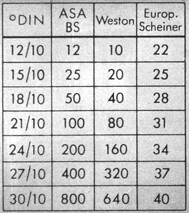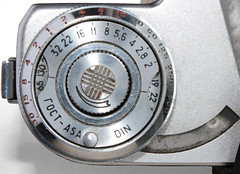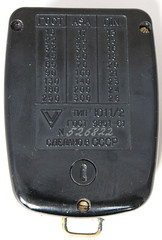Film speed
Speed is a measurement of how much light is needed to make a usable image on light-sensitive material such as film - in other words, a measure of sensitivity. "Faster" film requires less light, and so can be exposed at a faster shutter speed or smaller aperture. Film speed is represented on a numeric scale; on most scales, the higher the scale number, the less light that is required to expose the film. There are currently two numbering systems in use - ASA/ISO and DIN, but there have been various other predecessors.
"Fast" and "Slow" film
"Fast" film is more sensitive than average - typically with speeds of above 400 ISO/ASA - permitting photography in low light, or the use of high shutter speeds and small apertures, allowing freezing of motion (and reduced camera shake), or large depths of field. In other words, fast films can result in sharper pictures.
"Slow" film - say, speeds below 100 ISO/ASA - can be used for slow shutter speeds - for deliberate blurring of motion, or large apertures to give small depths of field for selective focusing.
The speed of a film is specified for a particular, standard method of processing. Using non-standard processing - e.g. changing the development times, temperature, chemical dilution or using different developer chemicals provides the photographer a choice of a range of speeds for any given film. Increasing the speed of film this way is called "pushing"; decreasing the speed of film is known as "pulling".
Quality trade-offs
It is common for fast film to have larger grain size and poorer rendering of colours (or grey scale) than slow film. This means that slow film can generally produce higher quality results than fast, but this must be balanced against the motion-stopping and depth of field available from fast films. Varying the development process - such as using a different developer - can also affect the quality and speed in similar ways.
Arithmetic v Logarithmic (Log) scales
There are two types of speed scales:
With an arithmetic scale, the exposure decreases in direct proportion to an increased speed - so a doubling in film speed requires half the exposure. For example if an exposure of 1/250s at f.8 is required for a 100 ISO film, a 200 ISO film would require either 1/500s at f.8, (or 1/250s at f.11) and 400 ISO film would need 1/1000s at f.8 for the same scene.
A logarithmic scale increases a fixed amount for a doubling of speed - 24 DIN is twice as fast as 21 DIN, and 27 DIN is four times as fast as 21.
Film Speed Scales

|
| Conversion table on the back of a Gossen Sixon light meter showing old DIN, ASA/BS, Weston and Europ-Scheiner (log) scales image by AWCam (Image rights) |
Current scales
- ISO/ASA/BS - current arithmetic scale, defined in standards by the International Standards Organisation (ISO 5800:1977[1], revised 1987; international), the American Standards Association (ASA PH2.5-1960, American), and British Standards (BS 1380, 1963, British); the newest term, ISO, is now the most commonly used name.
- DIN - current logarithmic system - defined in the German standard DIN 4512 (1961; defined by the Deutsches Institut für Normung), which was closely copied by the TGL 16150 standard in the DDR (the TGL standard was apparently a couple of years later than the original DIN - the older Neo-Din was still in use in the DDR in 1963)[2]; an increase of 3 is a doubling of speed. (21 DIN = 100 ISO/ASA and so 24 DIN = 200 ISO/ASA, 27 DIN = 400 ISO/ASA). The system was introduced in place of the previous so-called Neo-DIN of 1957.
Obsolete scales
- DIN (old) - the original system (known as the Alt-DIN today, i.e. Old DIN) was introduced in 1934 and was written as a fraction over 10 with a degree symbol (e.g. 21/10 °). As this system had been intended for separately developed single plates, when the large scale processing by industrial laboratories became common with different film types processed simultaneously in one tank, a new system was created in 1957, known as the Neo-DIN - it was written just with a degree symbol, e.g. 21°. Neo-DIN was superseded by the current 1961 DIN standard (known as the Neu-DIN, i.e. New DIN), which allowed receiving possibly equal contrast of all negatives, what was needed in an automated copying process[3]. To make things more complex, the Neo-DIN was also called DIN (neu) during its validation.
- ASA/BS (old)
- B.S. I (Index) - a long-outmoded logarithmic British Standard scale, with an increase of 3 being a doubling of speed; 21 B.S. I = 10 ASA; 31 B.S. I = 100ASA and 37 B.S. I = 400 ASA[4]
- Eder-Hecht - an obsolete log scale[5]

|
| Zenit E meter showing GOST and ASA equal image by AWCam (Image rights) |

|
| Conversion table on the back of a Leningrad 2 meter showing GOST, ASA & DIN; GOST 16-250=17-300 ASA image by AWCam (Image rights) |
- GOST (Cyrillic: ????) - a Russian arithmetic system. According to some sources, figures are about 25% larger than ASA/ISO (so 800ASA = ~1000GOST)[6], but others quote the relationship the other way around, GOST is 10% smaller (800ASA = ~720GOST)[7]. For most purposes, GOST ratings are near enough the same as ASA; this can be borne out by examining a Russian light meter or camera with a built in meter: many mark the same speed scale as GOST and ASA.
- Graphoskop Langer (2NK) an obsolete log scale[5]
- Hurter & Driffield (H & D) - an obsolete British arithmetic system introduced in 1890. Methods of establishing sensitivity were modified in 1925 (light source) and 1928 (light source, developer and proportional factor - this version is sometimes called H & D 10). The H & D system was accepted as a standard in the USSR until 1951.
- Ilford speed groups - a scale used on Ilford light meters, introduced in 1935[8]. The groups were lettered on meters from A (slowest films, 3-5ASA) to E (fastest, 50-80 ASA), or A-F on later meters, and matched Ilford's own film range. The groups went as high as H (400-650 ASA) by 1955[4]
- Scheiner speed - one of the earliest logarithmic systems; there were several slightly different Scheiner scales, such as Europ, American and Ilford.
- Warneke - an obsolete log scale, approximately Scheiner Log+10[5]
- Watkins - an obsolete arithmetic scale[5]
- Wellcome - an arithmetic fractional scale used on Wellcome exposure calculators, running inversely to most scales, where 1/48 = 100ASA, and 1/96=200ASA[4].
- Weston - an empirical arithmetic system, based on film developing tests, developed by the light-meter manufacturer. There was also a logarithmic (Weston-Scheiner) scale. Some other meter manufacturers had their own speed scales.
- Wynne f-number[5]
Speed in Digital Cameras
Digital camera sensors (e.g. CCDs) also have a certain sensitivity to light, meaning that a particular amount of light must register on the sensor for it to be converted into an image made of pixels. The amount of light can be measured and specified in the same way as film. Most digital cameras have automatic adjustment of the sensor's light sensitivity according to "scene recognition", or allow the user to alter it manually, usually via a menu. The effects of altering the light sensitivity of digital cameras are analogous to using different speeds of film: increasing the sensitivity allows faster shutter speeds and smaller apertures, and is particularly useful for photography in low light. For this reason, the film speed "equivalents" listed in digital camera specification charts have come to be known as their ISO capabilities. As with film, higher ISOs tend to degrade image quality. Rather than the analogue grain seen with film, digital sensors produce noise in the image, and this is particularly true with regard to image sensors that have smaller pixels. (A sensor that has 14 megapixels will tend to be noisier than a sensor of the same size with with 12 megapixels, since its pixels must be smaller or packed closer together in order to fit on the same-sized piece of silicon, and so each pixel can gather less light.)
Lower digital ISOs allow more accurate averaging and less truncation of digital values, and hence lower noise and better image quality. Most consumer cameras use built-in software to reduce the appearance of digital noise at high ISOs, however this can result in images that look smooth but lack detail, especially when enlargements are made. Unlike with film, the ISO rating of a digital camera can be changed on a shot-by-shot basis, allowing the photographer to shoot in a multitude of environments without changing the storage medium.
For several years, digital sensors did not have a range of "speeds" approaching those of fast film, at least not without obvious noise, but current (2010) DSLRs are capable of capturing light at higher ISO equivalents. Indeed, high-end models can now shoot effectively and with barely any detectable noise at ISO of 3200 or higher. Some even allow the user to select an ISO equivalent of over 50,000, which is far in excess of famous films made by Kodak, Ilford and Fuji.
Film speed conversion table
| ASA scale | DIN scale | GOST |
|---|---|---|
| 0.8 | 0° | |
| 1 | 1° | |
| 1.2 | 2° | |
| 1.6 | 3° | |
| 2 | 4° | |
| 2.5 | 5° | |
| 3 | 6° | |
| 4 | 7° | |
| 5 | 8° | |
| 6 | 9° | |
| 8 | 10° | |
| 10 | 11° | |
| 12 | 12° | 11 |
| 16 | 13° | 11 |
| 20 | 14° | 16 |
| 25 | 15° | 22 |
| 32 | 16° | 22 |
| 40 | 17° | 32 |
| 50 | 18° | 45 |
| 64 | 19° | 45 |
| 80 | 20° | 65 |
| 100 | 21° | 90 |
| 125 | 22° | 90 |
| 160 | 23° | 130 |
| 200 | 24° | 180 |
| 250 | 25° | 180 |
| 320 | 26° | 250 |
| 400 | 27° | 350 |
| 500 | 28° | 350 |
| 640 | 29° | 560 |
| 800 | 30° | 700 |
| 1000 | 31° | 700 |
| 1250 | 32° | |
| 1600 | 33° | |
| 2000 | 34° | |
| 2500 | 35° | |
| 3000 | 36° | |
| 3200 | 36° | |
| 4000 | 37° | |
| 5000 | 38° | |
| 6400 | 39° |
Sources
- ↑ | ISO 5800: 1977 Photography: Determination of ISO speed of colour negative films for still photography
- ↑ Teicher G. (ed.): Handbuch der Fototechnik; VEB Fotokinoverlag Halle, Halle (Saale), 1963.
- ↑ Teicher G. (ed.): Handbuch der Fototechnik; VEB Fotokinoverlag Leipzig, Leipzig, 1974.
- ↑ 4.0 4.1 4.2 Speed comparison table from Newnes Photographers' Pocket Reference Book, published by George Newnes Ltd, London, 1955, shown on Maurice Fisher's Photomemorabilia.
- ↑ 5.0 5.1 5.2 5.3 5.4 Gossen Photolux instruction booklet - flickr image by Simon Spaans
- ↑ Leningrad 4 user manual
- ↑ Focal Encyclopedia of Photography, Focal Press
- ↑ Ilford Exposure Meters article by Maurice Fisher